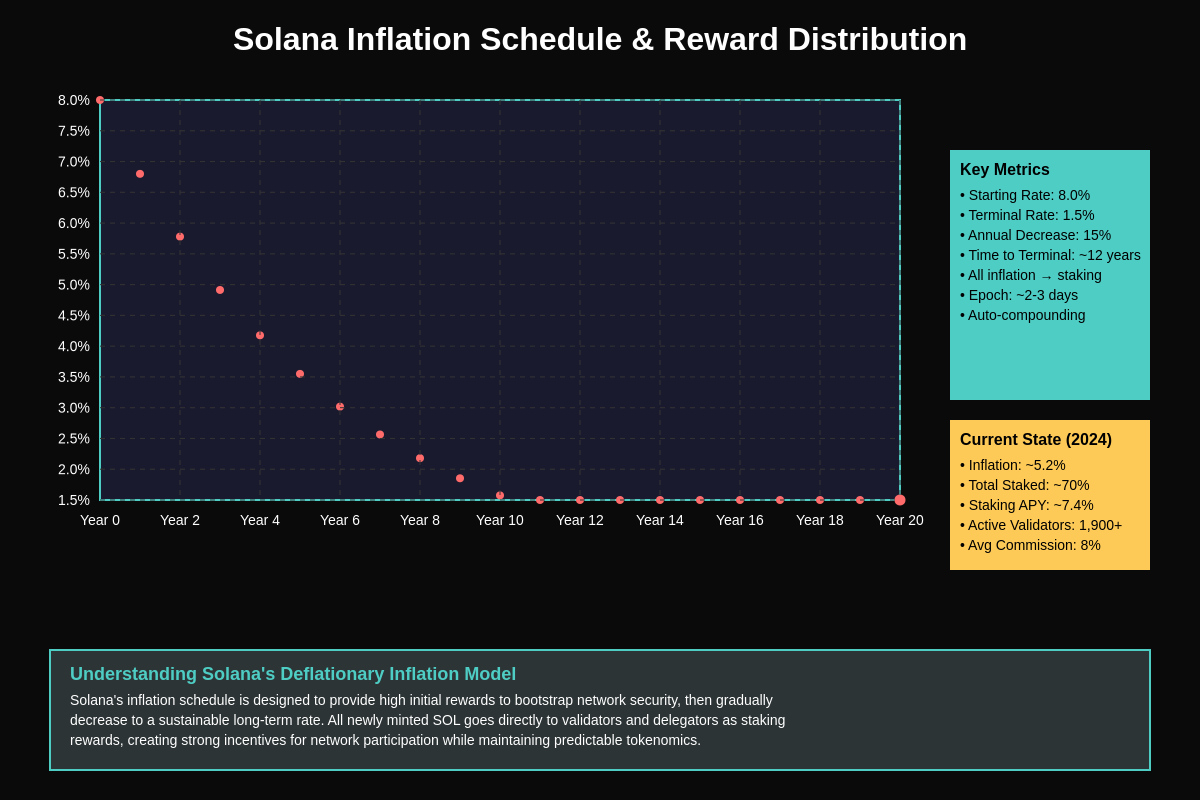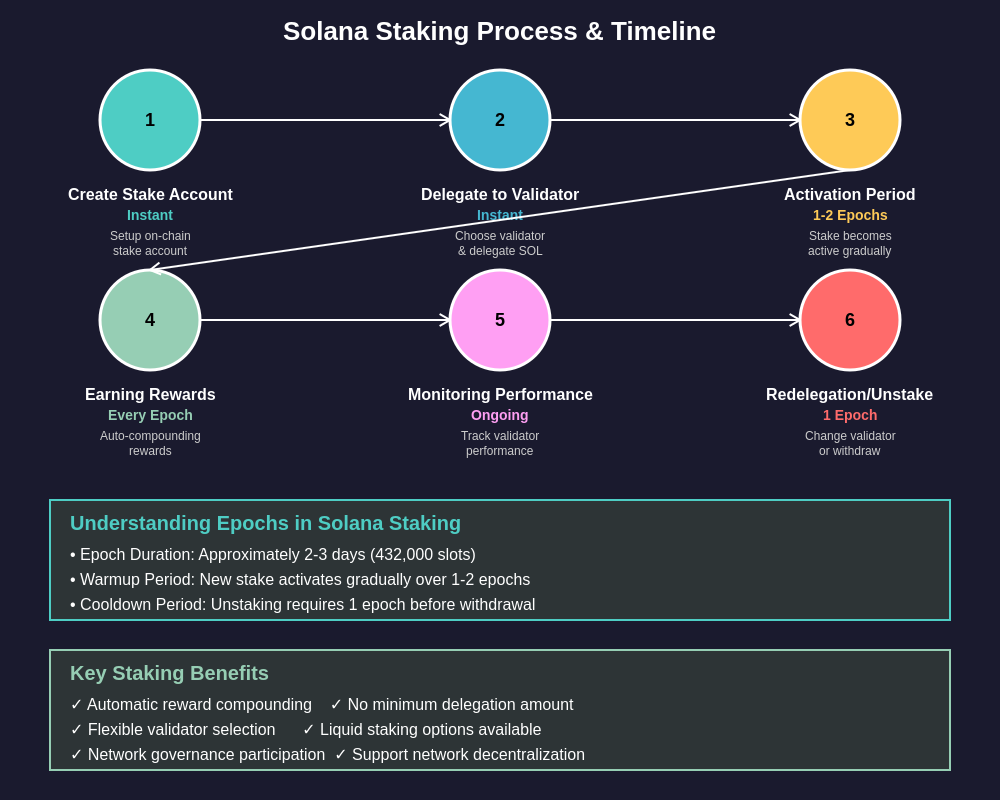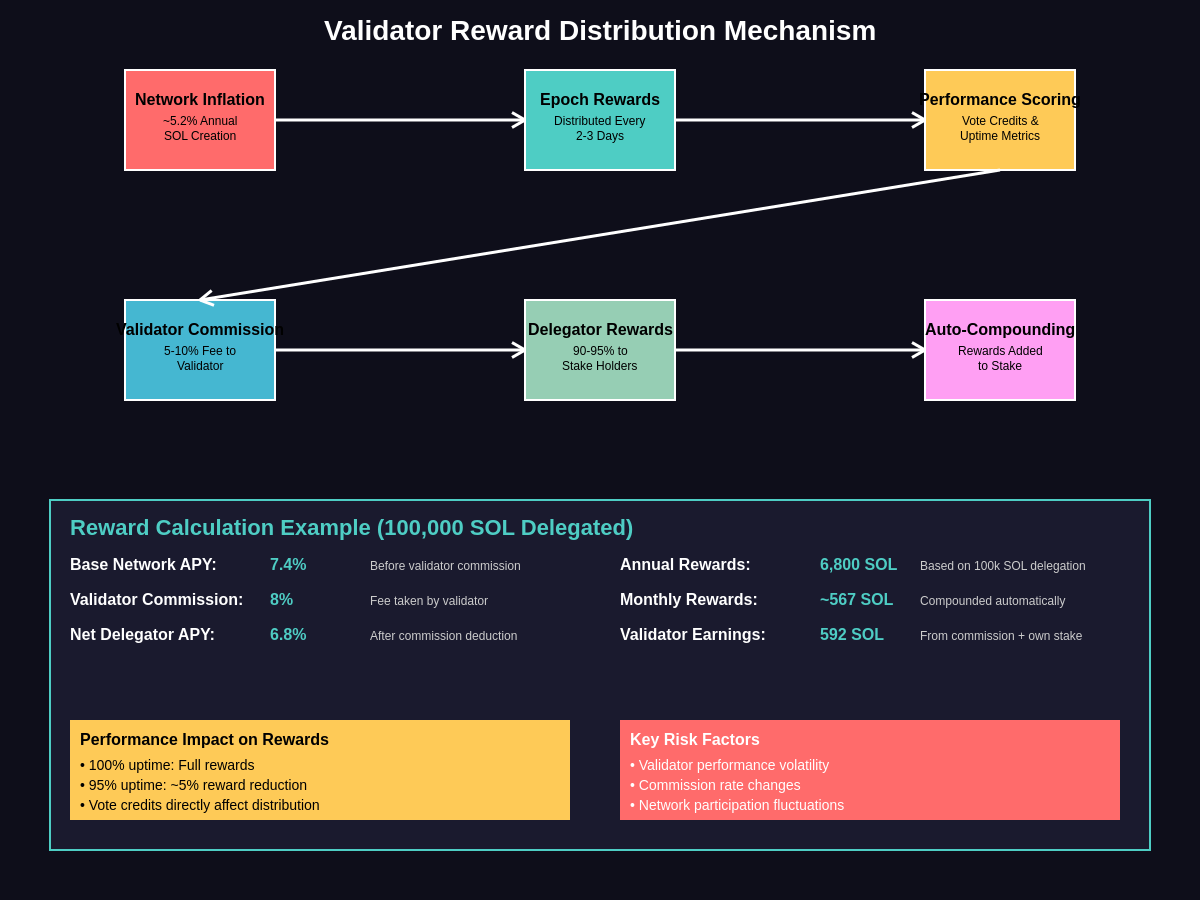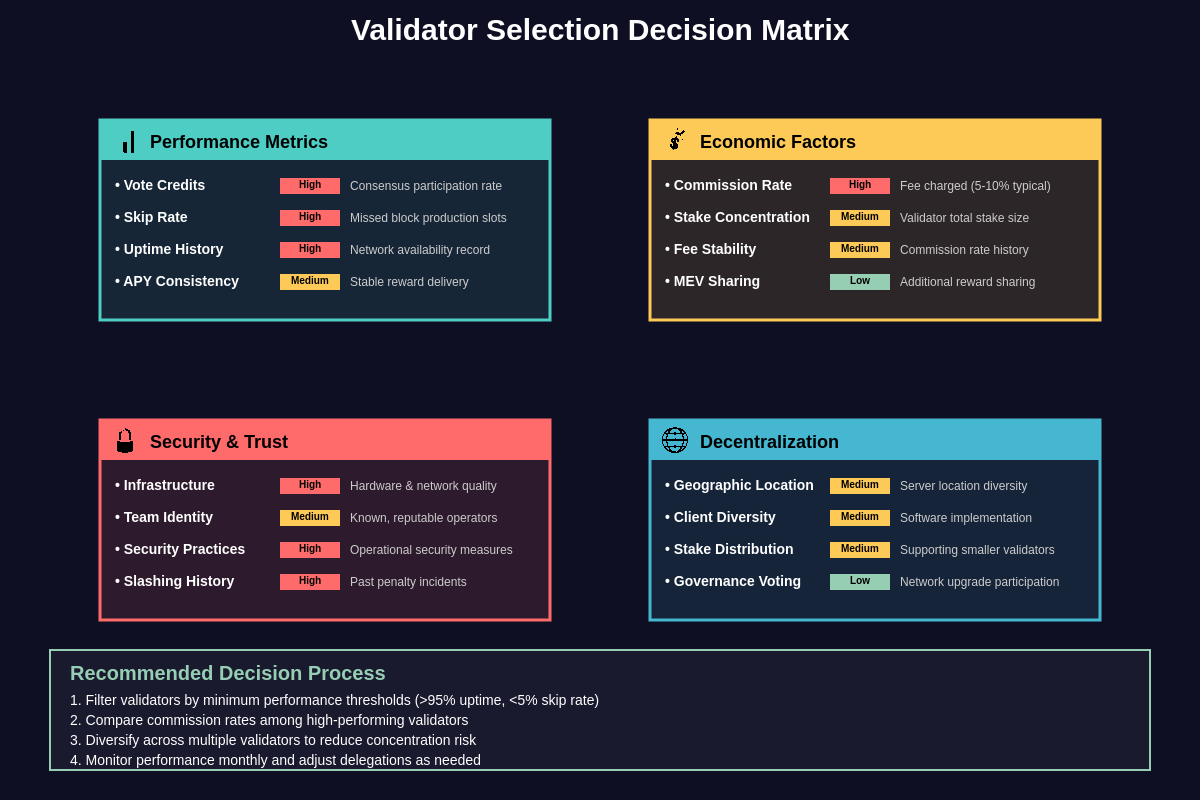For comprehensive trading insights and technical analysis tools, explore the TradingView platform which provides real-time SOL price data and advanced charting capabilities essential for understanding validator economics in relation to market conditions.
The Foundation of Solana’s Proof-of-Stake Consensus
Solana’s validator economics represent one of the most sophisticated and high-performance implementations of proof-of-stake consensus mechanisms in the cryptocurrency ecosystem, combining innovative technical architecture with carefully designed economic incentives to maintain network security while providing competitive staking rewards to participants. The network’s unique approach to consensus, incorporating both proof-of-stake validation and proof-of-history timestamping, creates a complex but highly efficient system where validators play a crucial role in maintaining the blockchain’s unprecedented transaction throughput and low latency characteristics.
The economic model underlying Solana’s validator system is designed to balance multiple competing objectives including network security, decentralization, performance optimization, and sustainable reward distribution to stakeholders. Unlike traditional proof-of-stake networks that may prioritize simple staking mechanics, Solana’s validator economics incorporate sophisticated elements such as vote credits, commission structures, performance-based rewards, and inflation-adjusted token distribution mechanisms that collectively create a dynamic and responsive economic ecosystem.
Understanding Solana’s validator economics requires examining the intricate relationships between network validators, delegated stake holders, inflation mechanisms, and performance metrics that collectively determine both individual validator profitability and overall network health. The system’s design reflects careful consideration of game theory principles, ensuring that validators are economically incentivized to act in the network’s best interests while providing predictable and competitive returns to those who delegate their SOL tokens to support network operations.

Validator Infrastructure and Technical Requirements
Operating a Solana validator requires substantial technical infrastructure and ongoing operational commitment, with hardware specifications that significantly exceed those required for validators on many other proof-of-stake networks due to Solana’s high-performance architecture and demanding computational requirements. Successful validators must maintain powerful server hardware capable of processing thousands of transactions per second while participating in the network’s consensus mechanism, requiring high-end processors, substantial RAM allocation, fast NVMe storage systems, and reliable high-bandwidth internet connections to ensure consistent performance and avoid penalties.
The technical complexity of running a Solana validator extends beyond basic hardware requirements to encompass sophisticated software management, security protocols, and operational procedures that demand continuous attention and expertise. Validators must maintain up-to-date software installations, implement robust security measures to protect against various attack vectors, establish reliable backup and disaster recovery procedures, and monitor network performance metrics to ensure optimal participation in the consensus process while maximizing earning potential through efficient operation.
Geographic distribution and network connectivity play crucial roles in validator performance and economics, as validators located in regions with superior internet infrastructure and lower latency connections to other network participants often achieve better performance metrics and correspondingly higher rewards. The global nature of the Solana network creates opportunities for validators in various regions while also establishing competitive dynamics where operational efficiency and technical sophistication directly impact economic returns through the network’s performance-based reward distribution mechanisms.
Energy efficiency considerations have become increasingly important in Solana validator economics, particularly as environmental sustainability concerns influence institutional adoption and regulatory approaches to cryptocurrency networks. While Solana’s proof-of-stake consensus mechanism is inherently more energy-efficient than proof-of-work systems, validators still face significant electricity costs that must be factored into economic calculations, with successful operators often implementing renewable energy solutions and advanced cooling systems to optimize their operational cost structures.
Staking Mechanics and Delegation Process
The delegation process in Solana’s staking system allows SOL token holders to participate in network security and earn rewards without operating validator infrastructure themselves, creating a democratic and accessible approach to network participation that has contributed significantly to Solana’s high overall stake participation rates. Delegators can choose from hundreds of active validators based on various criteria including commission rates, performance history, security track records, and alignment with their values regarding decentralization and network governance, with the delegation process designed to be user-friendly while providing sophisticated options for advanced participants.
Stake accounts in Solana function as specialized on-chain accounts that hold delegated SOL tokens and track various metrics related to staking performance, rewards accumulation, and delegation history, with the account structure designed to provide transparency and auditability while enabling efficient reward calculation and distribution. The system’s design allows for flexible stake management including the ability to split stake accounts, redelegate to different validators, and adjust delegation amounts while maintaining detailed records of all staking activities and associated rewards.
The warmup and cooldown periods associated with stake delegation serve important security and stability functions within Solana’s economic model, requiring newly delegated stake to gradually become active over several epochs while stake undelegation involves a cooling-off period during which tokens remain locked but no longer earn rewards. These mechanisms help prevent rapid stake movements that could destabilize the network while providing validators with predictable stake levels that enable efficient resource planning and operational decision-making.
Automatic reward reinvestment represents a significant advantage of Solana’s staking system, as earned rewards are automatically added to delegated stake amounts without requiring manual intervention from delegators, creating a compounding effect that enhances long-term returns while simplifying the user experience. This automatic compounding mechanism distinguishes Solana from many other staking systems that require manual claiming and reinvestment of rewards, providing a more efficient and user-friendly approach to long-term wealth accumulation through staking participation.

Inflation Schedule and Reward Distribution
Solana’s inflation schedule follows a carefully designed deflationary curve that begins with relatively high inflation rates designed to bootstrap network security through attractive staking rewards while gradually decreasing over time to approach a long-term sustainable inflation rate that balances ongoing security incentives with token holder value preservation. The initial inflation rate of approximately 8% annually is programmed to decrease by 15% each year until reaching a terminal inflation rate of 1.5%, creating a predictable long-term economic model that provides clarity for both validators and delegators planning their participation strategies.
The distribution of newly minted SOL tokens through the inflation mechanism is allocated entirely to validators and their delegators as staking rewards, with no allocation to development funds or other purposes, ensuring that network participants directly benefit from their contribution to network security while creating strong economic incentives for high stake participation rates. This approach contrasts with some other networks that allocate portions of inflation to various development or governance funds, making Solana’s model particularly attractive to yield-focused participants seeking maximum reward potential from their staking activities.
Epoch-based reward calculation and distribution provide predictable timing for reward accrual while enabling efficient batch processing of rewards across the entire network, with each epoch lasting approximately 2-3 days depending on network performance and providing regular opportunities for validators to demonstrate their performance and earn corresponding rewards. The epoch system creates natural cycles for network governance decisions, validator performance evaluation, and stake adjustment activities while providing delegators with regular feedback on their validator choices and reward earning potential.

The relationship between total network stake and individual reward rates creates dynamic incentives that help maintain optimal security levels while providing competitive returns to participants, with higher total stake percentages generally leading to lower individual reward rates but greater overall network security. This economic balance helps ensure that the network maintains adequate security through high participation rates while providing market-driven reward rates that adjust based on supply and demand dynamics within the staking ecosystem.
Commission Structures and Validator Economics
Validator commission rates represent a critical economic parameter that directly impacts both validator profitability and delegator returns, with most validators charging commission rates between 5-10% of earned rewards while some newer or competitive validators may offer lower rates to attract delegation. The commission structure serves multiple purposes including providing validators with revenue to cover operational costs and generate profits while creating market dynamics that encourage efficient operations and competitive service provision to delegators seeking optimal risk-adjusted returns.
The economics of validator operations involve substantial fixed costs including hardware procurement, electricity consumption, internet connectivity, security measures, and ongoing maintenance activities that must be covered through commission earnings and any self-delegated stake rewards. Successful validators must carefully balance commission rates to attract sufficient delegation while generating adequate revenue to maintain high-quality operations, creating market pressures that reward efficient operators while penalizing those with excessive cost structures or poor performance records.
Performance-based reward distribution means that validators with higher vote credits and better uptime records earn proportionally more rewards, creating strong economic incentives for maintaining excellent operational standards while providing delegators with clear criteria for evaluating validator quality. The system’s design ensures that both validators and delegators benefit from optimal performance, aligning economic interests and encouraging continuous improvement in validator operations and network reliability.
Geographic and jurisdictional considerations increasingly influence validator economics as regulatory environments evolve and institutional participants seek validators operating in favorable legal frameworks, with some validators highlighting their compliance posture and regulatory standing as competitive advantages in attracting institutional delegation. These factors add complexity to validator selection decisions while creating opportunities for operators who invest in compliance infrastructure and legal clarity in their jurisdictions.
Performance Metrics and Reward Optimization
Vote credit accumulation serves as the primary performance metric determining validator rewards, with validators earning credits for successful participation in consensus activities including block production, vote submission, and maintaining network synchronization across the distributed system. The vote credit system creates granular performance measurement that directly correlates with reward distribution, ensuring that validators who consistently contribute to network operations receive proportional compensation while those with performance issues face reduced rewards that reflect their diminished contribution to network security and functionality.
Skip rate optimization represents a crucial aspect of validator performance management, as validators who miss their assigned block production slots face reduced vote credits and correspondingly lower rewards, creating strong incentives for maintaining high-availability infrastructure and efficient operations. Successful validators invest heavily in redundant systems, monitoring tools, and operational procedures designed to minimize skip rates while maximizing their participation in the network’s consensus mechanism, with even small improvements in skip rates translating to meaningful differences in long-term reward accumulation.
Network connectivity and latency optimization play critical roles in validator performance, as validators with superior network connections and lower latency to other network participants often achieve better consensus participation rates and higher vote credit accumulation. This technical reality creates geographic advantages for validators located in major internet hubs while encouraging all validators to invest in high-quality network infrastructure and optimized routing configurations to maximize their competitive position within the validator ecosystem.
Monitoring and alerting systems enable validators to maintain optimal performance through real-time tracking of key metrics including vote credits, skip rates, network connectivity, system resources, and reward accumulation, with sophisticated operators implementing comprehensive monitoring solutions that provide early warning of potential issues before they impact performance. The complexity of Solana’s high-performance architecture demands equally sophisticated monitoring approaches that can detect and respond to performance degradation across multiple system components and network interaction patterns.
Stake Pool Mechanisms and Liquid Staking
Liquid staking protocols built on Solana enable participants to earn staking rewards while maintaining liquidity through tokenized representations of staked SOL, creating new opportunities for yield optimization and capital efficiency that expand the traditional staking paradigm beyond simple delegation mechanisms. These protocols typically issue liquid staking tokens that represent claims on underlying staked SOL plus accumulated rewards, allowing holders to utilize their staked assets in DeFi applications while continuing to earn validation rewards through the underlying staking mechanism.
The economics of liquid staking involve additional layers of fees and mechanisms including protocol fees charged by liquid staking providers, automated validator selection algorithms designed to optimize returns while maintaining decentralization, and sophisticated rebalancing mechanisms that adjust stake distribution across multiple validators to maximize performance and minimize risks. Participants in liquid staking protocols must evaluate these additional costs and mechanisms against the benefits of maintained liquidity and potential additional yield opportunities available through DeFi integration.
Stake pool governance introduces democratic decision-making processes for large-scale stake management, allowing participants to influence validator selection criteria, fee structures, and protocol upgrades while maintaining proportional voting rights based on their stake contributions. These governance mechanisms create additional complexity but also provide stakeholders with meaningful influence over protocol direction and economic parameters that directly impact their returns and risk exposure within the liquid staking ecosystem.
Risk considerations in liquid staking include smart contract risks associated with protocol implementations, validator selection risks that may differ from individual delegation choices, liquidity risks related to the tradability of liquid staking tokens, and governance risks associated with protocol changes that may impact the economic terms of participation. Sophisticated participants must evaluate these risks against the benefits of liquidity and potential enhanced returns when choosing between traditional delegation and liquid staking alternatives.
Economic Incentives and Network Security
The relationship between economic incentives and network security in Solana’s validator system creates a self-reinforcing cycle where higher stake participation increases network security while providing competitive returns that attract additional stake, resulting in a robust and economically sustainable security model. The network’s design ensures that validators and delegators are economically aligned with network health and security, creating natural defenses against attacks while providing predictable returns that encourage long-term participation and investment in network infrastructure.
Slashing risks in Solana are currently minimal compared to some other proof-of-stake networks, with the primary economic penalties related to performance degradation rather than explicit slashing for malicious behavior, though the network’s architecture includes provisions for future slashing implementations if needed for enhanced security. This approach reflects Solana’s focus on performance-based incentives rather than punitive measures, though participants should remain aware of potential future changes to slashing parameters as the network evolves and matures.
The economic security model relies on the assumption that the cost of acquiring sufficient stake to attack the network exceeds the potential benefits of such an attack, with current stake distribution and market capitalization providing substantial security margins against most conceivable attack scenarios. The network’s high performance and growing adoption create positive feedback loops that enhance economic security through increased stake value and participation rates, while the technical complexity of the network provides additional barriers to potential attackers.
Long-term sustainability considerations include the network’s ability to maintain adequate security through economic incentives as inflation rates decrease over time, requiring continued growth in network value and utility to maintain attractive real returns for validators and delegators. The transition from inflation-driven rewards to fee-driven rewards represents a critical evolution in the network’s economic model that will test the sustainability of current participation rates and security levels as transaction fees become an increasingly important component of validator economics.
Validator Selection Strategies for Delegators
Effective validator selection requires comprehensive evaluation of multiple factors including historical performance metrics, commission rates, operational transparency, security practices, and alignment with delegator values regarding network decentralization and governance participation. Sophisticated delegators often employ multi-criteria decision frameworks that weight these factors according to their individual priorities while considering the dynamic nature of validator performance and the importance of ongoing monitoring and evaluation of delegation choices.
Diversification strategies among multiple validators can help delegators optimize risk-adjusted returns while supporting network decentralization, though the complexity of managing multiple delegations must be weighed against the potential benefits of reduced concentration risk and enhanced reward stability. Some delegators choose to spread their stake across validators with different characteristics including geographic distribution, commission rates, and operational approaches to create balanced portfolios that support various aspects of network health while optimizing their individual returns.
Due diligence processes for validator evaluation should include examination of validator identity and background, technical infrastructure and security measures, historical performance data and consistency, community engagement and transparency, and alignment with delegator values regarding network governance and decentralization. The decentralized nature of validator operations means that delegators must rely on publicly available information and community resources to make informed decisions, highlighting the importance of validator transparency and community engagement in building trust and attracting delegation.

Ongoing monitoring and adjustment of delegation choices enable delegators to respond to changes in validator performance, commission rates, or operational practices while taking advantage of new opportunities that may arise within the validator ecosystem. Active delegation management requires regular evaluation of validator performance metrics, comparison with alternative options, and strategic decision-making about when to redelegate stake to optimize long-term returns while supporting network health and decentralization objectives.
Technological Evolution and Future Developments
The continuous evolution of Solana’s validator technology creates both opportunities and challenges for network participants, with ongoing developments in areas including consensus mechanisms, network architecture, validator tooling, and performance optimization potentially impacting the economic dynamics of validation and staking. Validators must stay current with technological developments while planning investments in infrastructure and operational capabilities that will remain competitive as the network evolves and scales to accommodate growing adoption and transaction volumes.
Proposed improvements to validator economics include potential modifications to reward distribution mechanisms, commission structures, performance measurement criteria, and inflation schedules that could significantly impact the economic calculations of both validators and delegators. Network governance processes provide stakeholders with opportunities to influence these developments while requiring ongoing engagement and participation in community discussions about the future direction of Solana’s economic model and technical architecture.
Integration with emerging technologies including mobile validation, edge computing, decentralized storage systems, and cross-chain protocols may create new opportunities for validator participation and revenue generation while potentially altering the competitive landscape and economic dynamics of network validation. Forward-thinking validators are exploring these emerging opportunities while maintaining focus on core validation responsibilities and performance optimization within the current network architecture.
Scalability improvements and network optimizations may impact validator requirements and economics as the network continues to grow and evolve, potentially changing hardware requirements, operational complexity, performance expectations, and reward distribution mechanisms in ways that affect both existing and prospective network participants. Understanding these potential changes and their implications for validator economics becomes increasingly important as the network matures and approaches broader mainstream adoption and institutional participation.
Risk Assessment and Mitigation Strategies
Technical risks associated with validator operations include hardware failures, software bugs, network connectivity issues, security vulnerabilities, and operational errors that can impact performance and reward earning potential, requiring comprehensive risk management strategies and mitigation measures. Successful validators implement redundant systems, robust security protocols, comprehensive monitoring and alerting capabilities, and detailed operational procedures designed to minimize the likelihood and impact of technical failures while maintaining optimal performance and maximizing reward accumulation.
Market risks affecting validator economics include SOL price volatility, changes in network adoption and transaction volumes, competitive dynamics within the validator ecosystem, regulatory developments, and broader cryptocurrency market conditions that can impact the economics of validation and staking participation. These risks require careful consideration by both validators and delegators when making long-term commitments to network participation while highlighting the importance of diversification and risk management strategies.
Regulatory risks related to staking activities vary significantly across jurisdictions and continue to evolve as governments develop frameworks for cryptocurrency regulation, potentially impacting the legal status of staking rewards, tax treatment of validation activities, and operational requirements for validators and staking service providers. Participants in Solana’s staking ecosystem should stay informed about regulatory developments in their jurisdictions while considering the potential impacts of changing regulatory environments on their participation strategies and economic outcomes.
Mitigation strategies for managing risks in Solana validator economics include diversification across multiple validators or staking approaches, maintaining appropriate insurance coverage where available, staying informed about technical and regulatory developments, implementing robust security measures, and maintaining flexibility to adapt to changing conditions within the network and broader cryptocurrency ecosystem. The dynamic nature of the cryptocurrency industry requires ongoing risk assessment and strategy adjustment to maintain optimal risk-adjusted returns while supporting network security and decentralization objectives.
Advanced SOL price analysis and market data help validators and delegators make informed decisions about staking strategies and timing, particularly when considering the impact of market conditions on validator economics and reward optimization strategies.
Conclusion and Strategic Outlook
Solana’s validator economics represent a sophisticated and evolving system that successfully balances network security, performance optimization, and participant rewards through carefully designed economic incentives and technical architecture that distinguish it from other proof-of-stake networks. The system’s emphasis on performance-based rewards, automatic compounding, and high participation rates creates a robust economic foundation that supports the network’s high-performance capabilities while providing competitive returns to validators and delegators who contribute to network security and operations.
The future development of Solana’s validator economics will likely continue to evolve in response to network growth, technological advances, regulatory developments, and competitive pressures within the broader cryptocurrency ecosystem, creating both opportunities and challenges for network participants. Success in this environment will require ongoing adaptation, continuous learning, and strategic decision-making that balances risk and return while supporting the long-term health and decentralization of the Solana network.
For participants considering involvement in Solana’s staking ecosystem, whether as validators or delegators, success requires comprehensive understanding of the technical, economic, and operational aspects of the system combined with ongoing monitoring and strategic management of participation choices. The network’s high-performance architecture and sophisticated economic model create opportunities for attractive returns while demanding careful attention to performance optimization, risk management, and strategic positioning within the competitive validator landscape.
The integration of traditional financial principles with innovative blockchain technology in Solana’s validator economics creates a unique and compelling value proposition that continues to attract participants seeking exposure to the growing decentralized finance ecosystem while earning predictable returns through network validation activities. As the network continues to mature and scale, the economic opportunities and challenges associated with validator participation will likely evolve, requiring ongoing education and adaptation from all network participants.
For the most current market analysis and SOL trading opportunities, utilize TradingView’s comprehensive platform which provides essential tools for tracking validator economics in relation to broader market trends and identifying optimal entry and exit points for staking strategies.
Disclaimer: This article is for informational purposes only and does not constitute financial advice. Cryptocurrency staking involves risks including potential loss of principal, technical risks, and regulatory uncertainties. Past performance does not guarantee future results. Readers should conduct their own research and consult with qualified financial advisors before making investment decisions. The author and publisher are not responsible for any financial losses that may result from the use of this information.